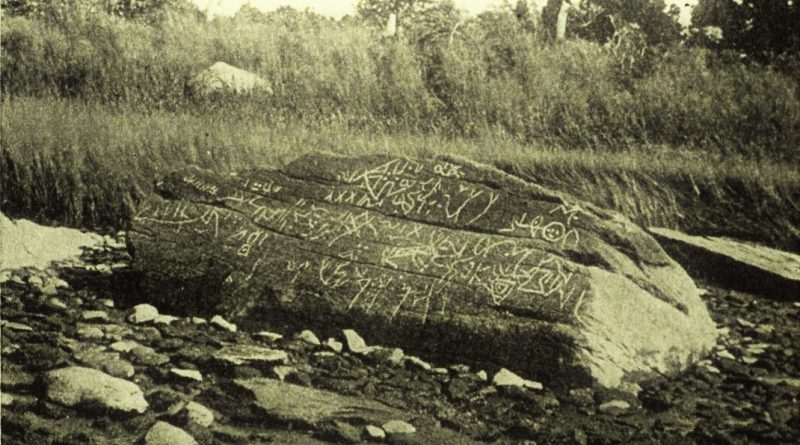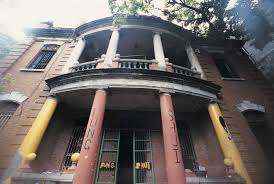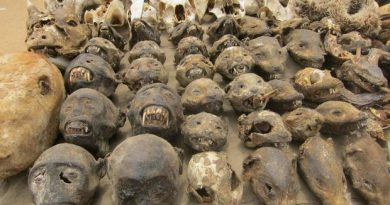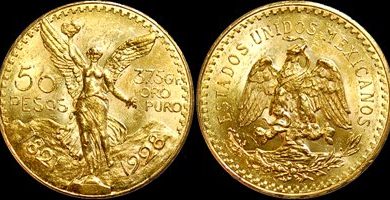Unexplained Mysteries of Dighton Rock
Dighton Rock is a mysterious tide-washed boulder that juts up out of the Taunton River at Assonet Neck, just across from the town of Dighton, Massachusetts, and the Dighton Yacht Club. To yachtsmen sailing the river and even to some residents of Assonet Neck, it looks like just another rock, about eleven feet long and five feet high, standing where the river widens abruptly on its way to Mount Hope Bay and the Atlantic Ocean. Until recently, no road has led to it, and few travelers ventured to follow the unmarked path which took them to the site. Yet to historians and archeologists, the rock has been a focus of marvel and speculation ever since the year A.D. 1690, when the Reverend Cotton Mather, of witchcraft and brimstone fame, described it and the curious message engraved on its weathered, red-brown sandstone face.
What has drawn attention about the great boulder is not the size, but the petroglyphs across one of its six sides. These carvings have been the inspiration for over 1000 books and articles, and the basis for over 35 hypotheses. Although no one can say for certain who was/were the maker(s) of the inscriptions on the petroglyph, it has been agreed that they certainly are very old and very real.
The Mystery of Dighton Rock
The first verifiable reference to the carvings on the boulder now called Dighton Rock dates back to 1680, when recent Harvard graduate John Danforth spotted the rock in what was then the town of Dighton and made a drawing of its carvings. That drawing — which is now in the collection of the British Museum — shows only the uppermost section of carvings, perhaps because the rest was obscured by water at the time of Danforth’s visit.
In the years that followed, many descriptions and drawings documented the “Dighton Writing Rock,” which even cropped up in the writings of such New England luminaries as Puritan minister Cotton Mather and poet James Russell Lowell.
As for who created the carvings and what they mean, there have been more than three dozen theories put forward over the years. Danforth probably had it right, though, when he suggested that the stone was the work of Native Americans. To his eye, it seemed to tell of an encounter and subsequent battle with visitors who arrived by ship.
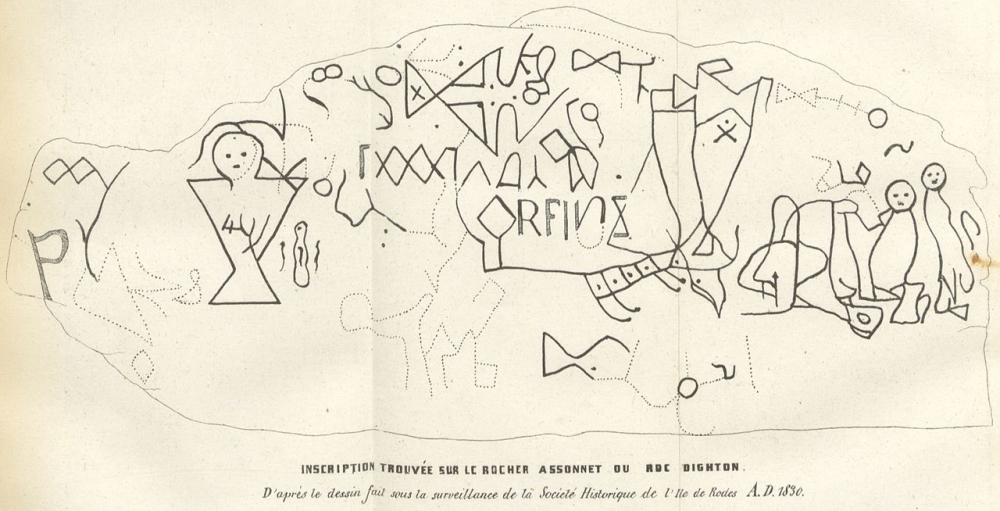
But despite the logic of Danforth’s theory (and the presence of many similar indigenous petroglyphs in the region), others have insisted that there must be a more creative story behind Dighton Rock. The 18th-century educator and theologian Ezra Stiles saw the stone as proof of a visit from ancient Phoenicians, while an alternative theory put forward around the same time attributed the carvings to long-ago visitors from Carthage. In the 19th century, Danish historian Carl Christian Rafn was convinced that Dighton Rock had been carved by Vikings. In the early 20th century, Brown University psychology professor Edmund Delabarre asserted that the carvings were Portuguese in origin. More recent theories have proposed Chinese, Japanese, or — of course — alien origins.
For most of its documented history, Dighton Rock sat in the Taunton River, whose rising waters sometimes obscured its art and where erosion took a heavy toll. It was located at a point where the river widens as it approaches Mount Hope Bay and the Atlantic Ocean beyond. In the rock’s original position, the carvings faced toward the sea. Were they intended as a message for visitors moving inland from the bay? That seems possible, but what could that message have been? Or what if the images were purely decorative, never intended to tell a story at all?
Who carved the baffling message into the face of the rock? And what does the message say? From Cotton Mather’s day to ours, there has been no lack of imaginative theories. For example:
In 1781 Count Antoine Court de Gebelin of Paris announced that he had fathomed the secret. Dighton Rock commemorated the visit to Massachusetts “in very ancient times” of a shipload of seamen from Carthage, who lived for a while on Mount Hope Bay and established friendly relations with the Indians there. The drawings on the rock, De Gebelin explained, portray the leaders of the expedition consulting an oracle in order to select an auspicious moment for the perilous voyage back to Carthage.
In 1807 Samuel Harris, Jr., a Harvard scholar, declared that he was able to decipher on the face of the rock three ancient Hebrew words in Phoenician letters: “king,” “priest,” and “idol.”
In 1831 Ira Hill, a Maryland schoolteacher, concluded that the rock was engraved in the second month of the tenth year of the reign of King Solomon by an expedition of Tyrians and Jews such as the one described in the Old Testament, I Kings 9:
And king Solomon made a navy of ships in Eziongeber… And Hiram sent in the navy his servants, shipmen that had knowledge of the sea, with the servants of Solomon. And they came to Ophir, and fetched from thence gold, four hundred and twenty talents, and brought it to king Solomon.
The drawings on the rock, Hill firmly believed, mapped in detail the voyage from the eastern Mediterranean through the Pillars of Hercules, past the Canary Islands, and on across the Atlantic to Assonet Neck.
Underlying such nonsense are lour solid facts:
Dighton Rock, unlike some dubious, more recently discovered “written rocks,” cannot be a modern forgery. It shows some trace of vandalism—the initials of tourists, for example—and an inscription reading (perhaps) “Injun Trail to Spring in Swomp → yds. 167.” But the bulk of the writings cannot be similarly explained. The Reverend John Danforth made a sketch of the marks engraved in the rock in October 1680. This sketch has been preserved in the British Museum. A comparison of Danforth’s sketch with the appearance of the rock today leaves no room for doubt that the inscription Danforth saw in 1680 is still there.
The lines on the rock were carved by human hands. They arc not mere cracks or products of freezing and weathering.
If the markings are just doodles, casually carved by Indians who had nothing better to do, they are surely among the most laborious doodles of all time. Even with a modern steel chisel it would take many hours, even days, to duplicate the inscription. The rock is partly submerged much of the time, so that doodlers might have had to stand in salt water up to their knees or waists. More convenient rocks were available for casual doodlings.
The message is blazoned on the offshore surface of the rock, facing the water; and the rock itself stands at a point where it would be conspicuous to any small vessel exploring the coast or putting into the Taunton River for fresh water. Through the centuries, therefore, most speculation has sought to interpret the carvings as a message left by visitors to the coast, intended to catch the eye of subsequent maritime explorers passing that way.
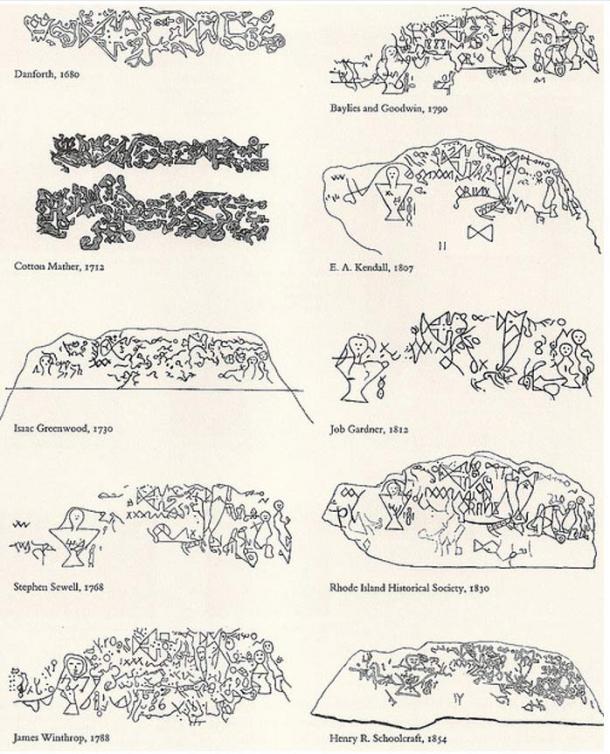
The most influential ol the theories clustering about the rock was one published in 1837 by a Danish scholar, Carl Christian RaIn. Rain had spent many years poring over the Icelandic manuscripts that told of early Viking voyages to the West. It was he who unearthed the now familiar story ol Leif the Lucky and his voyage in the year A.D. 1000 to three North American regions called Helluland, Markland, and Vinland. And Rafn also came upon the saga of Thorfinn Karlselne, who seven years later sailed even farther southward along the North American coast to a place called Hop. Thorfinn was accompanied by his wile Gudrida; at Hop, according to the saga, a baby boy named Snorro was born to them.
But where was Hop? In an effort to find out, the Danish scholar sent letters of inquiry to various American historical societies. Had the Vikings, perchance, IeIt any traces along the American coast?
One of Rafn’s letters aroused the Rhode Island Historical Society to action. Was it possible, the learned members asked themselves, that Dighton Rock bore a Viking message?
A special committee was formed to co-operate with Rafn; several expeditions were sent to the rock, and a drawing of the inscription, scrupulously prepared and checked, was forwarded to Denmark. On it, Rafn and his associate Finn Magnusen, like many others before and since, found just what they had been seeking [see illustrations on page 91]. They reported indubitable proof that Hop lay on the Taunton River.
Dighton Rock, they announced, portrayed in pictures precisely the episode described in the Norse sagas—“the famous ship of Thorfinn Karlsefne as it first set out for Vinland and came to this shore, with a windvane attached to the mast. His wife Gudrida, seated on the shore, holds in her hand the key of the conjugal dwelling.… Beside her stands their three year old son, Snorro, born in America.… A cock announces by his crowing domestic peace, as do also the shield at rest and the inverted helmet. Then suddenly approaching war is indicated. Thorfinn, leader of the colonists … seizes his shield and endeavors to protect himself against the approaching Skrellings, who violently assail the Scandinavians, armed with clubs or branches, with bow and arrows, and furthermore with a military machine, unknown to us, which in Thorfinn’s history is called a ballista.…”
To support this interpretation, Rafn and Magnusen even deciphered runic characters on the drawing which spelled out the words NAM THORFINS and the Roman numerals CXXXI. This they interpreted to mean “Thorfinn and his 151 companions took possession of this land.” The CXXXI was the clincher; for did not the sagas themselves report that Thorfinn’s party numbered 151? True, the Roman numerals CXXXI ordinarily stand for 131, but Rafn pointed out that the “C” might stand for the Norse “great hundred”—ten dozen, or 120. In that case the inscription and the saga would jibe.
Rafn’s researches excited international enthusiasm, and from 1837 on tne theory of pre-Columbian explorations of North America by the Vikings was almost universally accepted. Dighton Rock formed the last link in a long chain of evidence; for if it marked the site of Hop, then Helluland, Markland, and Vinland were surely Newfoundland, Nova Scotia, and either Cape Cod or Nantucket.
Alas, the Viking theory of the rock was completely demolished in 1916 by the late Professor Edmund B. Delabarre of Brown University. Dehtbarre, a psychologist as well as a literary detective, bought a summer home within a mile of the rock in 1912 and for the next 33 years devoted much of his scholarly energies to a study of its fabulous history. Most current knowledge of the rock is based squarely on his researches. In studying Rafn’s interpretation of the message, Delabarre procured photographs of the Rhode Island Historical Society’s original drawings from the Royal Library of Denmark in Copenhagen—and was amazed to find gross discrepancies between the society’s actual drawings and the doctored-up copies reproduced in Rafn’s book. Rafn had added many lines to support his theory. “On the drawing as he presented it,” Delabarre noted, “Rafn attempted to distinguish his own additions by drawing them with shaded lines. Unfortunately, the shadings are not very distinct, and are easily overlooked.” With Rafn’s doctoring eliminated, the whole Viking interpretation of the Dighton Rock inscription collapsed.
Dighton Rock, Delabarre concluded, was in all probability just one more example of the essentially meaningless markings often scratched into rocks by Indians. And as a psychologist he was able to explain why so many scholars had been deluded through the centuries. The rock, he declared, has an almost hypnotic effect on those who study it intently. In this respect it resembles a device known as the Rorschach test used by psychologists to dredge up unconscious levels of the mind. The Rorschach test presents lor interpretation colored ink blots printed on white cards. One man sees in these essentially meaningless blots a series of catastrophes—ships sinking, churches burning, volcanoes erupting. Another sees scenes of personal conflict—mothers scolding their children, brother fighting against brother. Dighton Rock, Professor Delabarre concluded alter long and intensive study, had since Cotton Mather’s day been serving as an ink blot for researchers, enabling them to see on it not what is really there but rather representations of the thoughts they have brought with them to the rock.
To illustrate this theory of “psychic projection,” Professor Delabarre told the story of a nineteenthcentury anthropologist, Henry Rowe Schoolcraft, who like many others was convinced that the inscription was of Indian origin. Schoolcraft took a drawing of the rock to the learned sage Chingwauk, an Algonquin Indian skilled in ke-kee-win , or Indian picture writing.
Chingwauk and a friend examined the drawing briefly, after which Chingwauk announced: “It is Indian; it appears to me and my friend to be a muz-zin-na-bik [rock-writing]. It relates to two nations.” He then disappeared into his tepee with the drawing and emerged the next day with a complete translation of the inscription into Algonquin! Chingwauk’s rendition was as preposterous as all the others.
Professor Delabarre could readily explain such aberrations of the human mind.
“Everyone knows,” he wrote, “how easy it is to see pictures that at least almost seem real things in clouds, in flames and embers, in wall-paper patterns, in the graining of wood and the veining of marble, in frostcovered window-panes.… Whenever we can, we tend to find something definite in the faint and orderly in the confused and to trust what we find.… There is a pleasure in seeing uncertainties and irregularities resolve themselves into definite form, and the forms take on connected and acceptable meaning. If the critical attitude be not aroused or find no support, if no conflicting appearances or beliefs occur to mind, if rival possibilities arouse no liking, the apperceptively constructed object must be believed to be external.”
Dighton Rock, Delabarre continued, is an ideal stimulus for such subjective apperceptions; it presents “an abundance of lines that are faint and doubtful, and a vast confusion of other marks that are clearly observable and may or may not be artificial. There are numberless little pittings and protrusions, irregularities of texture, almost eroded remnants of undecipherable characters, minute cracks, light-reflections varying from dark to bright forming dots and blotches, small differences of color. Such materials can be woven together apperceptively into a thousand varying forms.” Indeed, at the end of a long day spent poring over his collection of Dighton Rock drawings and photographs, Delabarre jotted this conclusion in his notebook: “After prolonged and close searching, I got so that I could find any given figure almost anywhere.”
Delabarre completed his monumental history of the rock in 1918 and was assembling the illustrations for publication, when—wait a minute!—what was that ?
Looking once more, very intently, at an eleven-yearold photograph of the rock on his desk, Delabarre made a most curious and unexpected discovery.
“It may well be imagined,” he later wrote, “with what astonishment, on examining the photograph for the hundredth time … I saw in it clearly and unmistakably the date 1511. No one had ever seen it before, on rock or photograph; yet once seen, its genuine presence on the rock cannot be doubted.”
Further study thereafter enabled Delabarre to decipher, along with the date, the emblazoned shield, or quinas , of the Kingdom of Portugal, and these graven letters:
MIGUEL CORTEREAL V. DEI HIC DUX IND.
Even a first-year Latin student could puzzle out the meaning: “Miguel Cortereal, by the will of God, here leader of the Indians.”
Who was Miguel Cortereal? He was the son of a Portuguese official, João Vaz Cortereal. According to family tradition, João sailed to Newfoundland and Labrador in 1472, two decades before Columbus’s first voyage. Whether or not João actually made that voyage, there can be no doubt that his son Caspar set sail from Portugal for the West in Columbus’s wake, with three ships, in 1501. Caspar’s vessels coasted along Labrador, Newfoundland, and Nova Scotia. Then, while two of his ships returned safely home, he turned his flagship south along the coast for further exploration. Nothing more was ever heard of Gaspar.
The following year, beyond any reasonable doubt, Miguel Cortereal sailed west in search of his brother. His two vessels reached Newfoundland in the early summer of 1502 and then separated, agreeing to a rendezvous on August 20. When Miguel failed to reach the rendezvous, the other ship returned to Portugal without him. Nothing more was ever heard of Miguel either—unless Delabarre was right in believing that Dighton Rock records his final message to the civilization he left behind.
Perhaps, Delabarre speculated—on the basis of local Indian traditions and other clues—Miguel Cortereal reached Mount Hope Bay in 1502 and sent men ashore near the site of Dighton Rock. Perhaps there was a battle with the Wampanoag Indians, perhaps a shipwreck, or perhaps for other reasons Miguel joined the Wampanoags. Because he possessed firearms and other marvelous equipment and skills, he was an obvious candidate for leadership. No doubt he kept close watch for vessels along the coast; but by 1511, his hopes of rescue having dimmed, he carved the message on the rock where it would stand for future generations.
Delabarre’s theory is widely accepted in Portugal; he was decorated by the Portuguese government for his researches, and his name is still held in affection among the large Portuguese-speaking population centered around Fall River, Massachusetts, half a dozen miles from the rock. The rock has even become a local political football in the Taunton-Fall River-New Bedford area; anyone in those parts who casts doubt on the Portuguese origin of the inscription is in danger ot being viewed almost as a traitor. Thanks to this renewed interest, steps are at last under way to preserve the rock for future generations.
